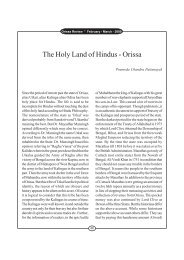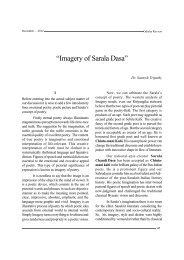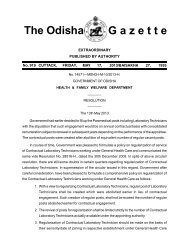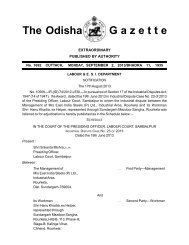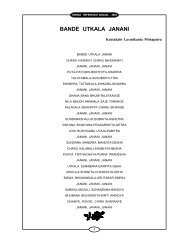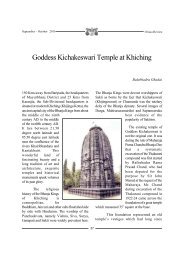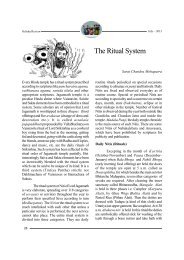Elephant Foot Yam : A Commercial Crop for Orissa
Elephant Foot Yam : A Commercial Crop for Orissa
Elephant Foot Yam : A Commercial Crop for Orissa
Create successful ePaper yourself
Turn your PDF publications into a flip-book with our unique Google optimized e-Paper software.
<strong>Orissa</strong> Review * August - 2006<br />
<strong>Elephant</strong> <strong>Foot</strong> <strong>Yam</strong> : A <strong>Commercial</strong><br />
<strong>Crop</strong> <strong>for</strong> <strong>Orissa</strong><br />
M. Nedunchezhiyan<br />
Abhinav Saurabh & Nirakar Ranasingh<br />
Amorphophallus paeoniifolius (Densst) Nicolson<br />
(Aracea), commonly known as <strong>Elephant</strong> foot yam,<br />
is a highly potential tropical tuber crop. The tubers<br />
are rich in nutrients. Pickles and<br />
many indigenous medicinal<br />
preparations are also made using<br />
its tubers. In India, it has attended<br />
the status of a cash crop and the<br />
area under its cultivation is<br />
increasing fast. It is a crop of<br />
South-east Asian origin, growing<br />
wild in the Philippines, Malaysia,<br />
Indonesia and Southeastern<br />
Asian countries.<br />
<strong>Elephant</strong> foot yam, grows<br />
well in hot (25-30° C) and humid<br />
(80-90% RH) climate. Hot and<br />
humid climate is required at<br />
initial stages of the crop growth<br />
<strong>for</strong> vigorous growth, whereas dry<br />
climates facilitate tuber bulking<br />
at later stage. Well-distributed<br />
rainfall of 1000-1500 mm is<br />
helpful <strong>for</strong> good growth and tuber yield. The crop<br />
can be grown in any soil types by raising the crop<br />
in pits filled with well decomposed cow dung and<br />
sandy loam soil; although well-drained, fertile,<br />
sandy loam soil is ideal <strong>for</strong> elephant foot yam<br />
cultivation.<br />
In India, this crop is traditionally cultivated<br />
in Andhra Pradesh, Gujarat, Maharastra and<br />
Kerala States. <strong>Orissa</strong> climate is highly suitable <strong>for</strong><br />
cultivation of elephant foot yam. It can be grown<br />
under rain-fed condition with protective irrigation.<br />
Farmer with elephant foot yam plant<br />
(var. Gajendra)<br />
71<br />
Wild plant of elephant foot yam is found throughout<br />
<strong>Orissa</strong>. The tubers of wild plants are highly<br />
acrid, causing irritation in throat and mouth due<br />
to excessive production of<br />
calcium oxalate present in the<br />
tubers. However, through<br />
research and development high<br />
yielding non-acrid varieties were<br />
released by different<br />
organizations.<br />
Varieties<br />
Gajendra: A local selection from<br />
Kovvur area of Andhra Pradesh<br />
is able to yield 50-60 t ha-1. The<br />
tubers are non-acrid, well shaped<br />
and generally devoid of cormels<br />
or propagules.<br />
Sree Padma: This variety was<br />
developed at Central Tuber<br />
<strong>Crop</strong>s Research Institute,<br />
Trivandrum, has a yield potential<br />
of 40 t ha-1. The tubers are non<br />
acrid and generally have one mother corm and a<br />
few cormels or propagules.<br />
Kusum: This variety was developed by Vidhan<br />
Chandra Krishi Viswavidyalaya (WB), has a yield<br />
potential and other features similar to “Gajendra”.<br />
<strong>Crop</strong>ping season<br />
<strong>Elephant</strong> foot yam is a long duration crop<br />
and generally attains maturity in 6-7 months.<br />
Under irrigated conditions, it is planted in summer<br />
(March) and attains maturity by November. Under
<strong>Orissa</strong> Review * August - 2006<br />
rain-fed conditions, the crop is planted at the onset<br />
of monsoon, preferably in June. Depending on the<br />
market’s demand, the harvesting can be started<br />
after 5-7 months. This crop has the sustainability<br />
to grow at any time of the year, provided,<br />
temperature is congenial and adequate soil<br />
moisture is available.<br />
Size of planting material<br />
Initial size of planting material plays most<br />
significant role in determining the final size of the<br />
harvested tubers. Results of research showed that<br />
400-500 g size whole tubers were more suitable<br />
<strong>for</strong> raising a commercial crop. Tubers of 3-4 kg<br />
can be harvested after six to seven months. This<br />
size is most suitable from marketing and transport<br />
point of view.<br />
Cut tubers of 50-100g sizes are used <strong>for</strong><br />
producing the planting material of 500-1000 g<br />
sizes. Although cut tubers can also be used as<br />
planting material, the use of whole tuber is<br />
significantly superior over cut tubers in terms of<br />
sprouting percentage and overall yield. When cut<br />
tubers are used <strong>for</strong> planting, certain precautions<br />
and treatments are needed as cut tubers are prone<br />
to decay after planting due to possible presence<br />
of several soil borne pathogens. Cut tuber pieces<br />
50-100 g are treated in thick cow dung slurry<br />
mixed with Mancozeb (0.2%) + Monocrotophos<br />
(0.05%) <strong>for</strong> 5-10 minutes, followed by drying in<br />
shade <strong>for</strong> 24 hours.<br />
Planting method<br />
The main field should be thoroughly<br />
ploughed, leveled and tilled be<strong>for</strong>e planting. The<br />
planting should be at 90 x 90 cm spacing <strong>for</strong><br />
commercial crop. The pit size of 60 x 60 x 60 cm<br />
should be dug out and refill the same soil with<br />
manures be<strong>for</strong>e planting <strong>for</strong> facilitating tuber<br />
bulking.<br />
Manures and fertilizers<br />
<strong>Elephant</strong> foot yam has high nutrient<br />
requirement. Well-decomposed cow dung compost<br />
@ 20-25 t ha-1 mixed with soil should be filled in<br />
pits only. A fertilizer dose of 100:80:100 kg N:P:K<br />
ha-1 has been found to be optimum. The fertilizer<br />
dose should be decided depending on the soil type<br />
and nutrient status.<br />
After care<br />
Mulching with organic waste or<br />
polyethylene sheets helps in reducing the weed<br />
growth and conserving soil moisture. For summer<br />
crop, a light irrigation should be provided<br />
immediately after planting. Depending on the soil<br />
moisture availability, irrigation should be given<br />
at regular intervals till the arrival of monsoon. Care<br />
should be taken to prevent water stagnation at<br />
every stage of crop growth. Irrigation should be<br />
withdrawn during the later stage of crop growth<br />
after 5-6 months of planting to allow the crop to<br />
mature.<br />
Intercropping<br />
During the initial period of 2-3 months after<br />
planting, crops like leafy vegetables, green gram,<br />
black gram, cowpea, cucumber; etc can be grown<br />
as inter-crop. Intercropping of elephant foot yam<br />
in banana, coconut and other newly planted<br />
orchards gives additional income to farmers.<br />
Regional Centre of CTCRI<br />
This Center has undertaken a massive<br />
programme on quality planting material of<br />
elephant foot yam production and supply along<br />
with other tuber crops. This program has been a<br />
great success and every year several metric tones<br />
are supplied to farmers and development agencies.<br />
M. Nedunchezhiyan is a Senior Scientist working<br />
Regional Centre of Central Tuber <strong>Crop</strong>s Research<br />
Institute, Dumduma, Bhubaneswar-751 019<br />
Abhinav Saurabh and Nirakar Ranasingh are SRF,<br />
Regional Centre of Central Tuber <strong>Crop</strong>s Research<br />
Institute, Dumduma, Bhubaneswar-751 019<br />
72




